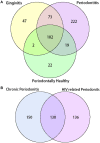Exploring salivary microbiota in AIDS patients with different periodontal statuses using 454 GS-FLX Titanium pyrosequencing
- PMID: 26191508
- PMCID: PMC4488753
- DOI: 10.3389/fcimb.2015.00055
Exploring salivary microbiota in AIDS patients with different periodontal statuses using 454 GS-FLX Titanium pyrosequencing
Abstract
Patients with acquired immunodeficiency syndrome (AIDS) are at high risk of opportunistic infections. Oral manifestations have been associated with the level of immunosuppression, these include periodontal diseases, and understanding the microbial populations in the oral cavity is crucial for clinical management. The aim of this study was to examine the salivary bacterial diversity in patients newly admitted to the AIDS ward of the Public Health Clinical Center (China). Saliva samples were collected from 15 patients with AIDS who were randomly recruited between December 2013 and March 2014. Extracted DNA was used as template to amplify bacterial 16S rRNA. Sequencing of the amplicon library was performed using a 454 GS-FLX Titanium sequencing platform. Reads were optimized and clustered into operational taxonomic units for further analysis. A total of 10 bacterial phyla (106 genera) were detected. Firmicutes, Bacteroidetes, and Proteobacteria were preponderant in the salivary microbiota in AIDS patients. The pathogen, Capnocytophaga sp., and others not considered pathogenic such as Neisseria elongata, Streptococcus mitis, and Mycoplasma salivarium but which may be opportunistic infective agents were detected. Dialister pneumosintes, Eubacterium infirmum, Rothia mucilaginosa, and Treponema parvum were preponderant in AIDS patients with periodontitis. Patients with necrotic periodontitis had a distinct salivary bacterial profile from those with chronic periodontitis. This is the first study using advanced sequencing techniques focused on hospitalized AIDS patients showing the diversity of their salivary microbiota.
Keywords: acquired immunodeficiency syndrome; diversity; microbiota; opportunistic infections; periodontal diseases.
Figures




Similar articles
-
Pyrosequencing Analysis of Subgingival Microbiota in Distinct Periodontal Conditions.J Dent Res. 2015 Jul;94(7):921-7. doi: 10.1177/0022034515583531. Epub 2015 Apr 22. J Dent Res. 2015. PMID: 25904141
-
Anal microbiota profiles in HIV-positive and HIV-negative MSM.AIDS. 2014 Mar 13;28(5):753-60. doi: 10.1097/QAD.0000000000000154. AIDS. 2014. PMID: 24335481
-
The salivary microbiome for differentiating individuals: proof of principle.Microbes Infect. 2016 Jun;18(6):399-405. doi: 10.1016/j.micinf.2016.03.011. Epub 2016 Apr 8. Microbes Infect. 2016. PMID: 27063111
-
The oral microbiome and human health.J Oral Sci. 2017;59(2):201-206. doi: 10.2334/josnusd.16-0856. J Oral Sci. 2017. PMID: 28637979 Review.
-
Comparative analysis of bacterial abundance and diversity in tumour tissue of oral squamous cell carcinoma and non-tumour tissue: insights from a systematic review of 16S ribosomal RNA sequencing.BMC Oral Health. 2025 Apr 16;25(1):577. doi: 10.1186/s12903-025-05941-3. BMC Oral Health. 2025. PMID: 40241078 Free PMC article.
Cited by
-
Significant effect of HIV/HAART on oral microbiota using multivariate analysis.Sci Rep. 2019 Dec 27;9(1):19946. doi: 10.1038/s41598-019-55703-9. Sci Rep. 2019. PMID: 31882580 Free PMC article.
-
Septic polyarthritis with Mycoplasma salivarium in a patient with common variable immunodeficiency: case report and review of the literature.Access Microbiol. 2021 Apr 9;3(4):000221. doi: 10.1099/acmi.0.000221. eCollection 2021. Access Microbiol. 2021. PMID: 34151172 Free PMC article.
-
Oral microbiome and history of smoking and colorectal cancer.J Epidemiol Res. 2016 Oct;2(2):92-101. doi: 10.5430/jer.v2n2p92. J Epidemiol Res. 2016. PMID: 28111632 Free PMC article.
-
Altered Salivary Microbiome in the Early Stage of HIV Infections among Young Chinese Men Who Have Sex with Men (MSM).Pathogens. 2020 Nov 19;9(11):960. doi: 10.3390/pathogens9110960. Pathogens. 2020. PMID: 33228000 Free PMC article.
-
Skin microbiome profile in people living with HIV/AIDS in Cameroon.Front Cell Infect Microbiol. 2023 Oct 31;13:1211899. doi: 10.3389/fcimb.2023.1211899. eCollection 2023. Front Cell Infect Microbiol. 2023. PMID: 38029259 Free PMC article.
References
Publication types
MeSH terms
Substances
LinkOut - more resources
Full Text Sources
Other Literature Sources
Medical

